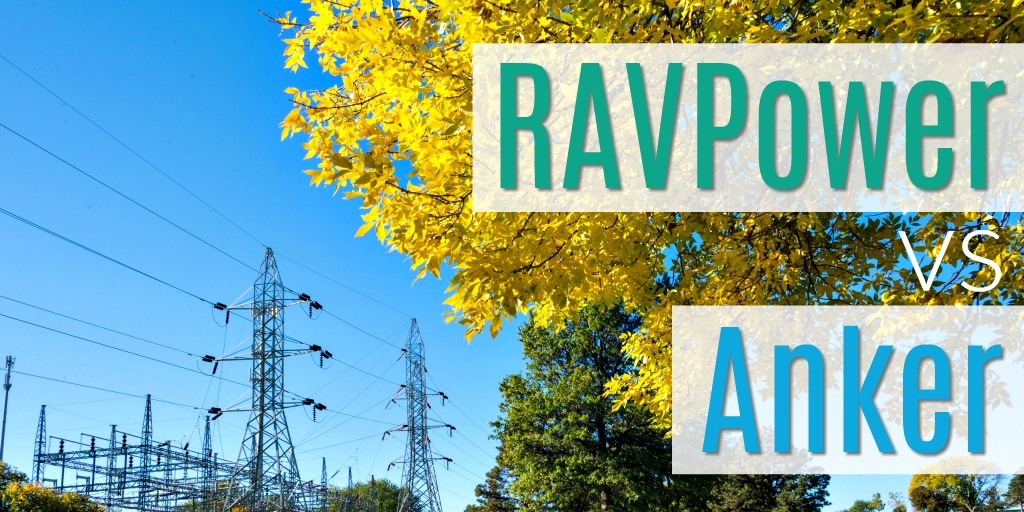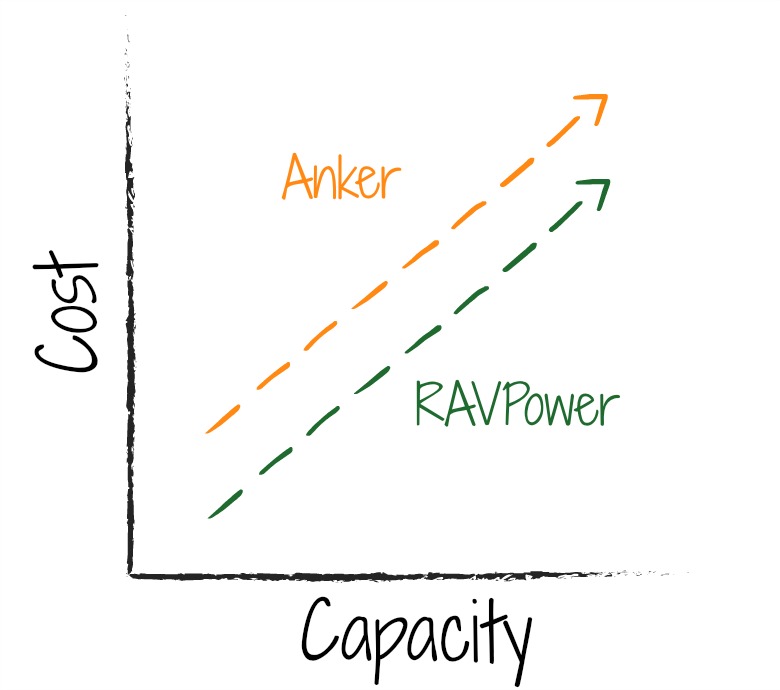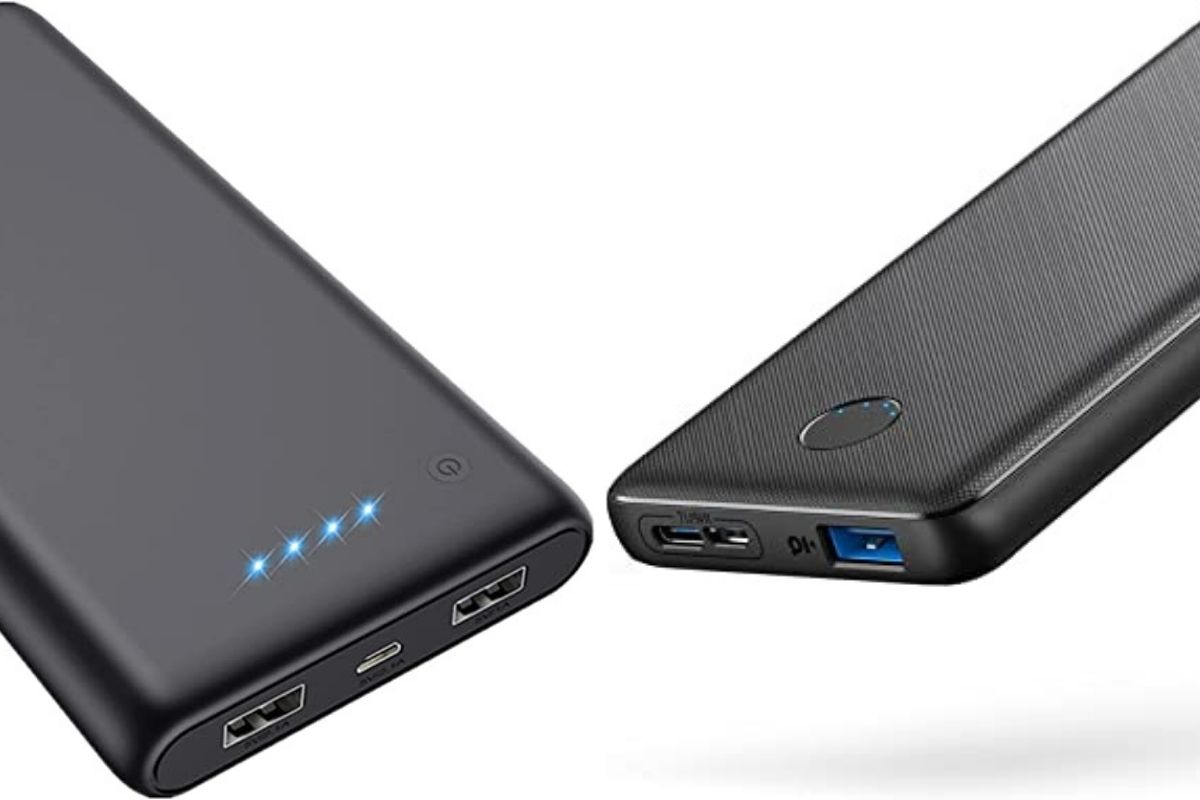Like most of you reading this, I love camping and hiking because it offers me a much-needed break from the responsibilities of every day life.
There’s something extremely cathartic about gathering wood, starting a fire, and watching my stress billow away with the smoke as the sun sets over the horizon.
But as much as I like to surround myself with nature to simplify my life, I’m still a 30-something guy living in the 21st century.
I need my tech!
Between my smartphone and Bluetooth speaker, I have definite power needs while I’m trying to unplug from society.
That’s why no outdoor excursion is complete without a fully charged power bank.
If you’re reading this article, it’s probably because you’re looking for the power bank that best suits your needs.
And your research has probably led you to two popular brands:
- RAVPower
- Anker
What are the differences between the two manufacturers and which one is better?
Related: Aukey vs Anker: Who Wins?
We break it down in The Outdoor Authority’s RAVPower vs Anker comparison.
RAVPower

Anker

Table Of Contents
Tips for Choosing the Right Power Bank

At first glance it seems easy enough:
Choose the model with the biggest numbers for the lowest price.
But what do all those numbers mean?
And should you care about anything other than the numbers?
Let’s answer those questions, but let’s do it in reverse.

7 things to look for when power bank shopping
Allow me to list out the 7 things you should look for when shopping for a new power bank:
- Capacity
- Max current
- Charging speed
- Included accessories and cables
- Dimensions and weight
- Cost
- Warranty
Those 7 factors fall into 3 categories:
- Pretty straightforward: 5, 6, and 7
- Make sense but maybe you didn’t consider: 3 and 4
- May be foreign if you aren’t into tech: 1 and 2
(Why am I still doing things in reverse?)
Let’s knock out the easy ones here. These are the things you should look for.

7. Warranty // Longer is better.
6. Cost // Lower is better.
5. Dimensions and weight // Smaller is (usually) better.
4. Included accessories and cables // Consider both what you’ll be charging with your power bank and how you’ll be re-charging your power bank.
And now, the numbers stuff.
What do all those numbers mean?
Tech stuff always has numbers associated with it, also known as technical specifications.
You use these specs to compare various models (along with factors 4-7 above) to dial in exactly what you need for the price you’re willing to pay.
For power banks, there are 3 technical specifications we care about.
And for the sake of consistency, let’s keep going backwards!
3. Charging speed // The rate at which the power bank recharges. Many power banks have a turbo charge feature where they fill, say, 50% of the way super fast and then charge the final 50% more slowly.
2. Max current // Current is measured in amperes, abbreviated as amps (A), and with power banks you’ll usually see 2 different outputs: 1A and 2.1A. Most phones charge on the lower 1A current whereas most tablets, laptops, and other larger devices charge using the 2.1A current. If you want to be able to charge those larger devices, make sure your power bank has a max output of at least 2.1A. Please note you can still charge a phone with a 2.1A power bank, it’ll just throttle down to the phone’s 1A current.
1. Capacity // This is the most oft-cited number when you read about batteries and power banks. Measured in milli Ampere-hours (mAh), capacity is the amount of energy a battery stores. A higher mAh rating means the battery can store more energy.
How many charges will I get out of a power bank?
While it seems logical to say that a 15000mAh battery will fully charge a 3000mAh cell phone 5 times, that’s actually incorrect! You also need to factor in the voltage in/out of the battery and the inherent inefficiency of the battery, which is generally at least 10%. (This means about 10% of the energy stored in the battery is lost to the internal components and isn’t transferred to your device.) Read here for full details on calculating the number of charge cycles from a given battery.
As the note above explains, calculating the number of charge cycles in a power bank isn’t totally straightforward, but at a high level you can say more mAh equals more stored energy.

RAVPower vs Anker: The Comparison
Comparing RAVPower vs Anker at the “brand name” level doesn’t really mean comparing technical specifications.
For both brands you’ll find smaller pocket-sized models with very low capacity and huge models intended to give you days of recharges to most of your devices. You’ll also find plenty of models in the middle.
Instead, this comparison really comes down to one major factor.
RAVPower is the more affordable brand
All things equal, meaning the same basic power bank with the same technical specifications, RAVPower’s version is usually cheaper.
How much cheaper?
Let’s compare a few similar RAVPower vs Anker power banks.
And for those more visually inclined, have a look at our super precise chart of RAVPower vs Anker costs:

At almost every size power bank, the RAVPower version will be less expensive.
That begs a very obvious question:
If RAVPower is cheaper, why would you ever want to buy an Anker power bank?
From my perspective, here’s the single best reason to go with Anker over RAVPower.

Anker power banks recharge almost twice as quickly
Anker power banks, specifically those with PowerCore II technology, charge much more quickly than similar RAVPower models. Consider the following 20000 mAh models, which store enough energy to charge and iPhone 7 six times, a Galaxy S8 four times, or an iPad Air 2 nearly two times:
- RAVPower 20000 mAh power pack: 9-10 hours for full recharge
- Anker 20000 mAh power back: 5 hours for full recharge
That’s a significant improvement in recharge performance.
How does it work?
Check out this image from the Anker website.

Quick Charge technology allows the device (in this case the power bank) to rapidly charge up to 80% capacity before trickling the rest of the way to 100%.
A comment about the image above: It’s a little misleading in one key way. The 35 minute time elapsed metric is for a 3000mAh cell phone and not a 20000+ mAh power bank. However, the Anker 20000 mAh Quick Charge 3.0 power bank will charge to 80% capacity in just 60 minutes. You’ll get 80% of the way to a full charge incredibly quickly and 100% of the way there not long thereafter.
Now, if you’re a well-organized individual who plans properly and charges their power pack ahead of time, the RAVPower’s longer recharge time will be fine.
But if you’re disorganized (like me) or will be recharging on the road from coffee shops, rest stops, or other locations (also like me), then Anker’s rapid recharging might be best for you.
Note: You may need a Quick Charge charger to take advantage of this Anker benefit. Here’s a wall mount version and here’s a car charger version.
Also important to remember is that technology is advancing all the time and RAVPower and similar brands may unleash Quick Charge power banks too. While comparison shopping for any power bank, check to see if it offers Quick Charge 3.0 technology.
Wait, don’t forget about the warranty!
Stupid me.
There’s another key difference between RAVPower and Anker, and it gives RAVPower another point.
Both manufacturers offer a 12 month warranty on their products, but RAVPower offers an additional 18 months for registering your product. And it’s totally free.
Click here to view RAVPower’s free extended warranty page.
RAVPower vs Anker: The Bottom Line
Over 1,000 words later, it’s time to summarize.
Which power bank manufacturer is better?
As always, it comes down to your specific situation. To recap, here are the differences:
- RAVPower products generally are more affordable for the same technical specs.
- RAVPower offers a free 18 months additional warranty for registering your device.
- Anker power banks have better components and recharge almost twice as quickly.

